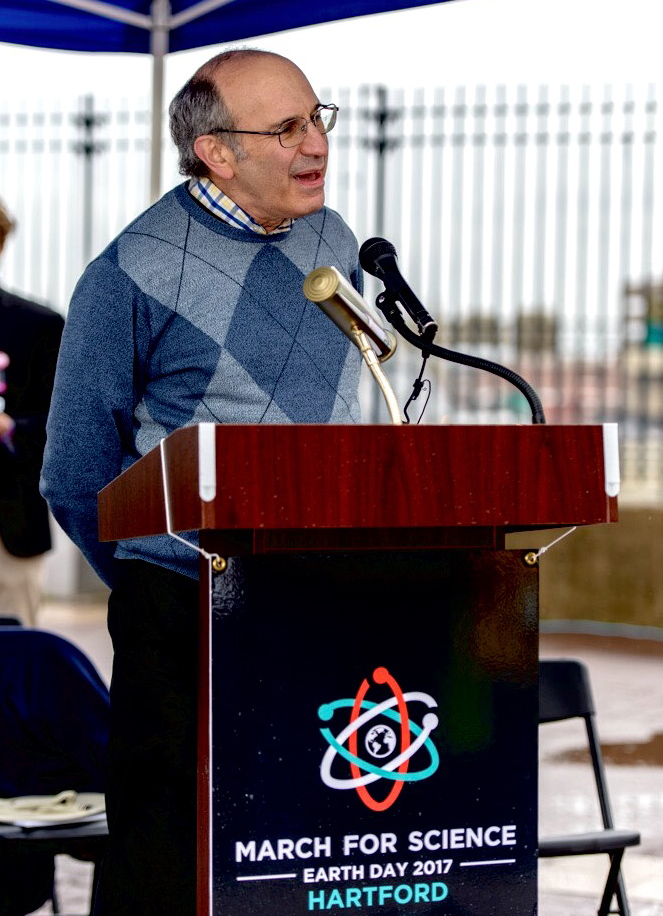Cohan: Human Behavior Affects Virus Evolution


Frederick Cohan, the Huffington Foundation Professor in the College of the Environment, professor of biology, is a microbial ecologist whose course “Global Change and Infectious Disease” examines how human disturbance of the environment contributes to infectious disease outbreaks. He also researches the origins of diversity among both bacteria and viruses.
In early February, as the novel coronavirus was beginning to spread, Cohan wrote an article in The Conversation, co-authored with PhD candidate Kathleen Sagarin and Kelly Mei ’20, titled, “A Clue to Stopping Coronavirus: Knowing How Viruses Adapt From Animals to Humans.”
Cohan also was interviewed recently by The Wesleyan Argus about the biology of the coronavirus.
You teach a course on Global Change and Infectious Disease, which looks at how human disturbance of the environment can contribute to infectious disease outbreaks like the one we’re now living through. Can you give us a brief introduction to the course?
I teach this course every year or two, and there are usually over 170 students enrolled. I’m also in the middle of writing a book based on the course content. We talk about five categories of environmental disturbance that humans are creating or have created in the past that bring new diseases to us or exacerbate existing ones. The categories are: demand for food (hunting and agriculture), demand for land (living at high density), demand for travel, demand for energy, and demand for health care (including antibiotics).
These things will keep on happening forever. I call it the unending plagues. As the coronavirus pandemic makes abundantly clear, there is no end to the viruses that can come into humanity from wild animals. We also deal with ethics in the course, and discuss how we can change our behavior and our priorities to limit the spread of infections and prevent more new diseases from making their way into humanity.
That’s fascinating. How do our behaviors influence the evolution of viruses?
Once a virus comes into humanity, it can evolve to become a better human virus. Even for long-existing viruses within humanity, there are ways that they can tweak their settings to become more successful as we change our behaviors. For example, as humans developed sanitation improvements and secured the water supply, fecal-oral pathogens have adapted so they’re no longer passing from person to person by way of the drinking supply. That is, the virus becomes less virulent so people feel well enough to go out in public and spread the virus by way of public restrooms.
Mosquito-borne infections are another interesting example. Malaria is brought into this country numerous times every year, but it never really spreads in a community way. That’s because it makes people so sick that they usually go right to the hospital or to bed. They’re behind window screens or in air conditioning, so mosquitos don’t have a chance to bite them and spread the illness. In contrast, Zika produces mild symptoms in people, so those infected with it stay out in circulation, allowing the disease to spread. It doesn’t have a big effect on adults, but can be disastrous for fetuses, as we know. I think the Zika virus is primed to do really well in the United States as our environment gets warmer.
In an interview on WSHU Public Radio, you argued that it’s critical to develop a vaccine for COVID-19 before it evolves to become more efficient in its transmission. Have we seen evidence that the novel coronavirus is evolving?
This is an RNA virus, and all RNA viruses have a very rapid rate of evolution. So we know that the virus is evolving, but it’s not clear if any of these changes are of consequence for how transmissible it is or the symptoms it causes.
A group of researchers in China has hypothesized that there was an ancestral form of the coronavirus in Wuhan that produced a fairly mild infection, and it got replaced with a more virulent form of the virus last year. The natural selection argument for this is that when things are business as usual and people are congregating and breathing on each other in public spaces, those people with the more virulent form, who are coughing and sneezing a lot, would spread the virus very quickly. Once China began implementing strict quarantining earlier this year, the game changed for the virus because any person showing symptoms (that is, those infected with the more virulent form) would be quickly tested and quarantined. Only those who have no noticeable symptoms—i.e., people with the milder form—would still be out in public and spreading the infection, albeit at a lower rate.
Again, this is all still pretty hypothetical. I believe it will be increasingly important that virus genome sequences be readily linked to “metadata” beyond the sequences—in this case, the level of symptoms endured. Then we may understand why certain sequences are increasing in frequency and why certain geographic regions have higher frequencies of certain virus sequences.
How optimistic are you about our ability to control the spread of the virus?
I don’t have much doubt that we will eventually get an effective vaccine. At the very worst, we will have to update the vaccine year after year—like we do with the flu vaccine—but it’s not clear yet if that will be necessary. Some viruses, like rabies, have been controlled with the same vaccine for many years.
But that vaccine will take time to develop. I believe that if the US had reacted to the virus similarly to places like China, South Korea, Hong Kong, and Singapore, we would be ready to get back to work in two months or so, as they have. However, I believe for various reasons that we are incapable of doing what is necessary.
So, what is necessary? First, we all need to buy in to social distancing in all its various forms. I see this as difficult because of the political polarization in this country and the lack of respect for expert knowledge. We also would need a federal directive for social distancing to make up for the stubborn resistance of some governors, and that’s not coming. It doesn’t help, of course, that Trump so recently downplayed the importance of social distancing beyond Easter, before changing his mind on this. Even if we start seeing new virus cases go way down, it’s critical that we don’t abandon social distancing way too soon, as I fear some will.
Second, we need to go beyond social distancing to contact tracing and testing of all individuals who are connected to a known case of COVID-19, and quarantining those who test positive. We still don’t have the testing capacity to do this, owing to a lack of direction from the federal government. Without the on-the-ground identification and quarantining of those infected, it will be very difficult to match the success of those East Asian countries.
A third problem is that we still don’t have adequate PPEs (Personal Protective Equipment) for health care workers, which means that we run the risk of health care workers becoming infected and passing on the infection to their patients.
Finally, our country will suffer from a failure of federal leadership to guarantee production and distribution of life-saving devices such as ventilators. All these failures will lead, I fear, to a much longer chain of infection here in the US compared to China and South Korea.

